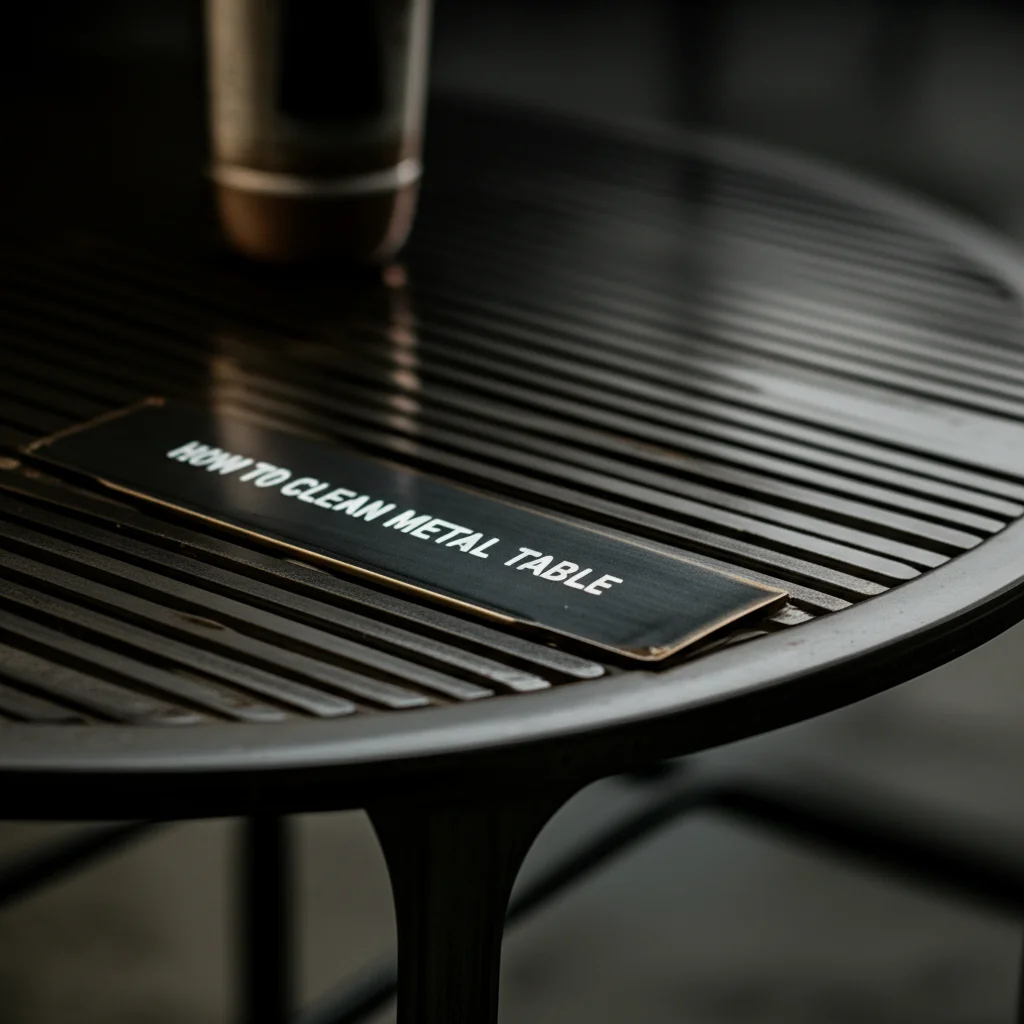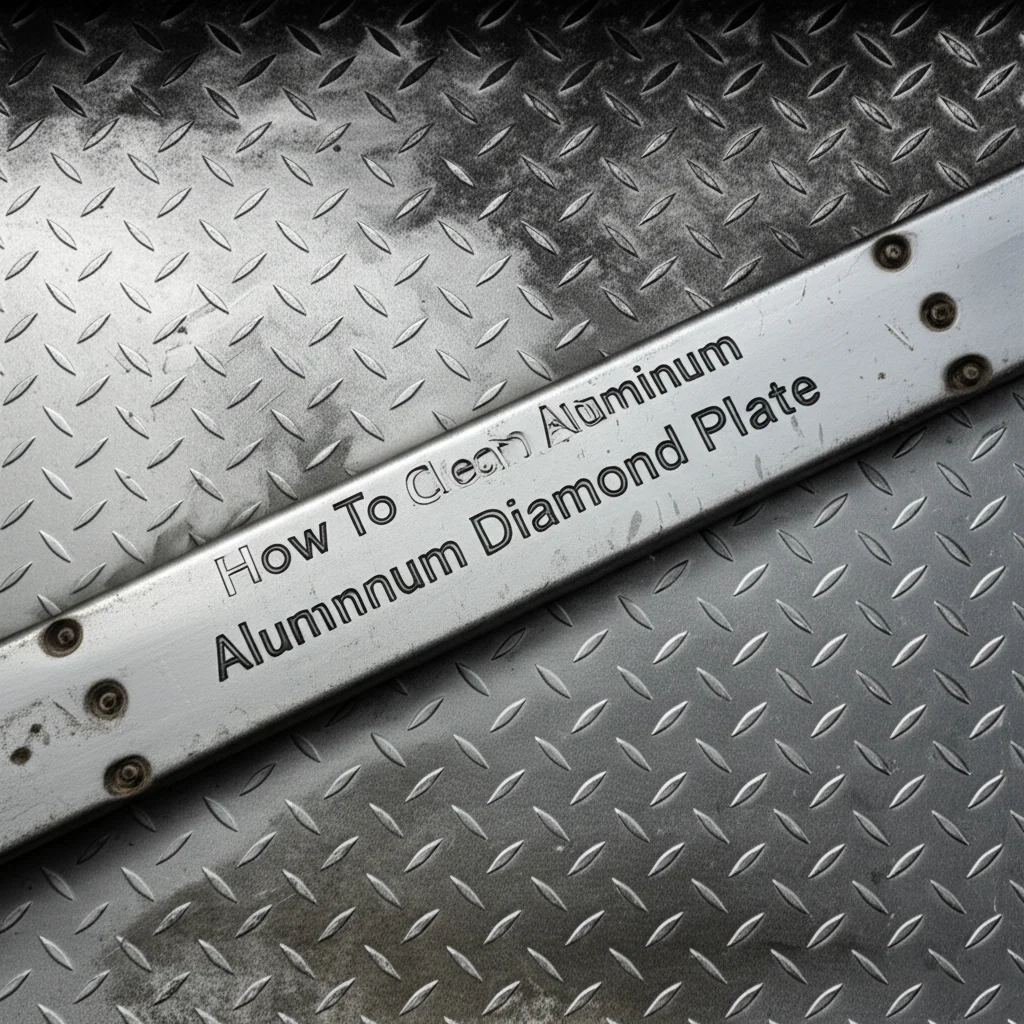· Todd Martin · Home Care · 17 min read
How To Clean Polished Aluminum

Restore the Gleam: How to Clean Polished Aluminum
Polished aluminum adds a sleek, modern touch to many items in our homes and vehicles. It looks beautiful, reflecting light and creating a sense of pristine cleanliness. However, this reflective surface can quickly lose its luster. Dirt, grime, and even oxidation can make polished aluminum appear dull or discolored. Knowing how to clean polished aluminum properly helps you keep these surfaces looking new.
This guide provides simple steps for cleaning polished aluminum. We will explore the right tools and cleaning solutions. You will learn basic cleaning methods for light dirt. We also cover how to handle tougher stains and oxidation. Finally, we will discuss how to protect your polished aluminum for lasting shine. Let’s make your aluminum pieces sparkle again.
Takeaway
- Use gentle methods and non-abrasive cloths for routine cleaning.
- Address oxidation and stubborn stains with specialized products or homemade solutions.
- Always test cleaning products in a small, hidden area first.
- Finish with a polish and protective sealant to maintain shine.
- Regular cleaning prevents buildup and extends the life of your polished aluminum.
How to clean polished aluminum? To clean polished aluminum, start by wiping off loose dirt with a soft cloth. Then, use a mild soap and water solution, gently scrubbing with a non-abrasive sponge. Rinse thoroughly and dry immediately to prevent water spots. For deeper cleaning or oxidation, use a dedicated aluminum polish or a paste of baking soda and water, rubbing gently before rinsing and drying.
Understanding Polished Aluminum and Its Care Needs
Polished aluminum is popular for its bright, mirrored finish. Manufacturers achieve this finish through mechanical or chemical polishing processes. Unlike anodized aluminum, which has a protective oxide layer, polished aluminum is often more exposed. This exposure means it can react with air and moisture. The result is often a dull appearance or even light corrosion over time.
Dust, fingerprints, and general grime are common problems. These can make a bright surface look dirty fast. When aluminum oxidizes, it forms a white, powdery film. This film takes away the shine. Understanding these issues helps us choose the right cleaning methods. Our goal is to clean effectively without harming the delicate surface.
Different types of aluminum items have different care needs. For instance, an aluminum pan used for cooking will have different residues than a decorative aluminum trim. Knowing what the item is and its typical exposure helps determine how often it needs cleaning. For items in contact with food, gentle, non-toxic cleaners are best. For outdoor items, more robust solutions might be necessary to fight environmental elements.
Polished aluminum requires a delicate touch. Abrasive cleaners or harsh scrubbing can create scratches. Scratches ruin the smooth, reflective finish. It is important to use soft materials. Always choose cleaners that are safe for polished metals. This prevents damage while ensuring good cleaning results. Properly cared for polished aluminum will maintain its attractive look for many years. Regular cleaning prevents dirt from building up. This also stops minor oxidation from becoming a larger problem.
Maintaining the shine of your polished aluminum depends on understanding what it is made of and what it needs. Aluminum is a reactive metal. It forms a thin, protective oxide layer naturally. Polishing removes this layer to create the shine. This means the polished surface is more prone to dulling. Proper care makes sure that the surface stays bright and clean.
We must remember that polished aluminum is not always the same as other aluminum finishes. For example, how to clean anodized aluminum involves different considerations due to its protective coating. Similarly, when you clean aluminum parts, such as how to clean aluminum castings, the surface texture and specific contaminants might require different approaches. Our focus here is on that smooth, reflective surface that shows every smudge.
Essential Tools and Supplies for Cleaning Polished Aluminum
Gathering the right tools and supplies makes the cleaning process easier and more effective. You do not need many items to start. The key is to use gentle materials. Harsh brushes or abrasive pads can scratch polished aluminum. Always choose soft options. This protects the finish.
Here is a list of essential items:
- Soft cloths: Microfiber cloths are excellent. They are gentle and highly absorbent. You will need several for cleaning, rinsing, and drying.
- Mild dish soap: A small amount of gentle dish soap mixed with water creates a good cleaning solution. Choose one without strong degreasers or harsh chemicals.
- Warm water: Water helps dissolve dirt and rinse surfaces clean.
- Spray bottle: A spray bottle allows for easy application of your cleaning solution.
- Soft brush or sponge: A soft-bristled brush can help get into crevices. A non-abrasive sponge is good for broader surfaces.
- Polished aluminum cleaner/polish: For deeper cleaning or restoring shine, a specific aluminum polish works best. These products often have mild abrasives or chemical agents to remove oxidation.
- White vinegar (optional): A solution of equal parts white vinegar and water can help remove some stains.
- Baking soda (optional): A paste made from baking soda and water can tackle tougher spots and light oxidation.
- Rubbing alcohol (optional): Good for removing stubborn grease or sticky residues.
Before you begin, always test any cleaning solution or product in a small, hidden area. This helps ensure it will not discolor or damage the aluminum. You want to see how the aluminum reacts. If the area looks good, you can proceed with confidence. This testing step is important for all cleaning tasks.
Having everything ready saves time. It also prevents you from stopping in the middle of cleaning. Prepare your workspace. Protect surrounding areas if needed. This is especially true if you are working on a larger item or something that cannot be easily moved. Using the right supplies makes cleaning aluminum rims with household products much easier and safer for the finish. Similarly, when you clean kitchen items, knowing how to clean an aluminum pan properly means choosing the right soft tools and gentle cleaners to protect the cooking surface and shine.
Step-by-Step Guide to Basic Polished Aluminum Cleaning
Cleaning polished aluminum regularly prevents dirt from building up. This keeps the surface looking its best. Basic cleaning is simple and does not take much time. This method works well for light dust, fingerprints, and everyday grime. Follow these steps for routine maintenance.
Remove loose dirt: Start by wiping the polished aluminum surface with a dry, soft microfiber cloth. This removes dust, crumbs, and any loose debris. This step prevents scratching the surface when you introduce moisture. Gently wipe in one direction.
Prepare a cleaning solution: Mix a few drops of mild dish soap with warm water in a spray bottle or a small bucket. The solution should be slightly sudsy but not overly bubbly. You want a gentle cleaner.
Apply the solution: Spray the cleaning solution onto a clean microfiber cloth, not directly onto the aluminum. This controls the amount of moisture. Then, gently wipe the polished aluminum surface. Work in small sections if the item is large. Use light, even strokes. Do not scrub hard.
Rinse the surface: After cleaning, use another clean cloth dampened with plain water to wipe away the soap residue. It is important to remove all soap. Leftover soap can leave streaks or a dull film. Rinse thoroughly.
Dry immediately: This is a crucial step for polished aluminum. Use a third clean, dry microfiber cloth to dry the surface completely. Drying immediately prevents water spots and streaks. Air drying can leave mineral deposits. Buff lightly as you dry to enhance the shine.
This basic method is safe for most polished aluminum items. It is ideal for regular upkeep. For items like window frames, where the aluminum might be exposed to varying weather, understanding how to clean aluminum window frames with this gentle approach can extend their lifespan. Similarly, cleaning something like how to clean aluminum blinds requires a soft touch to avoid bending or scratching the slats. Even when dealing with larger outdoor surfaces, knowing how to clean aluminum siding can often begin with these same gentle principles before considering stronger methods. Regular care with simple tools makes a big difference in maintaining the bright finish.
Tackling Stubborn Stains and Oxidation on Polished Aluminum
Sometimes, basic cleaning is not enough. Polished aluminum can develop stubborn stains, water spots, or signs of oxidation. Oxidation appears as a white, chalky film. These problems need a stronger approach than just soap and water. You will use slightly more specialized methods or products here.
Removing Water Spots and Mild Stains
Water spots are common. They happen when water dries on the surface and leaves mineral deposits.
- Vinegar solution: Mix equal parts white vinegar and water. Dampen a soft cloth with this solution. Gently wipe the water spots or stains. The acid in vinegar helps dissolve mineral deposits.
- Lemon juice: For a natural alternative, squeeze fresh lemon juice onto a soft cloth. Apply it to the stained area. Lemon juice contains citric acid, which works similarly to vinegar.
- Rubbing alcohol: For greasy stains or sticky residues, a small amount of rubbing alcohol on a microfiber cloth can be effective. Wipe gently, then rinse with plain water.
After using any of these solutions, always rinse the area with plain water. Then dry it immediately and completely with a clean, dry cloth. This prevents new spots.
Addressing Oxidation and Deeper Discoloration
Oxidation is the biggest challenge for polished aluminum. It dulls the shine. It can even cause pitting if left untreated.
- Baking soda paste: Make a paste using baking soda and a small amount of water. Apply the paste to the oxidized areas. Let it sit for a few minutes. Then, gently rub it with a soft cloth or sponge. Rub in the direction of the grain, if visible. Baking soda is a mild abrasive. It helps lift the oxidation without scratching. Rinse thoroughly and dry.
- Cream of Tartar: Mix cream of tartar with a few drops of water to form a paste. Apply it to the oxidized area. Let it sit for 5-10 minutes. Gently rub with a soft cloth. Rinse well and dry. This method is good for light to moderate oxidation.
- Commercial Aluminum Polish: For severe oxidation or to restore a mirror-like shine, a dedicated commercial aluminum polish is often the best choice. These products contain very fine abrasives or chemical agents designed to remove oxidation. Follow the product instructions carefully. Apply with a soft cloth, rub gently, and then buff to a shine. Always use proper ventilation when working with chemical polishes.
When dealing with significant corroded aluminum, these steps become even more important. Understanding how to clean oxidation from aluminum effectively is key to restoring the metal’s appearance. For example, if you are cleaning car parts, tackling oxidized aluminum wheels often requires a dedicated polish and careful technique to bring back their brilliance. Always remember to test any new product on an inconspicuous spot before applying it to the entire surface.
Polishing and Protecting Your Aluminum for Lasting Shine
After cleaning, the next step is polishing. This brings back the mirror-like shine to your polished aluminum. Protection then helps maintain that shine. It also slows down future oxidation and staining. Think of polishing as the final touch. Protection is like an invisible shield.
Polishing Polished Aluminum
Polishing removes any remaining haze or minor imperfections. It reveals the true luster of the metal.
- Choose your polish: Select a reputable commercial aluminum polish. These products are formulated to be gentle yet effective on polished surfaces. Some polishes also contain sealants for added protection. Read the label carefully to ensure it is suitable for polished aluminum.
- Apply the polish: Apply a small amount of polish to a clean, soft microfiber cloth. Do not apply directly to the aluminum.
- Rub in small sections: Work in small areas, rubbing the polish onto the aluminum in circular motions or back and forth, following the grain if present. Apply light to moderate pressure. You will often see a dark residue forming on your cloth. This is normal. It means the polish is working to remove microscopic layers of oxidation and dirt.
- Buff to a shine: Once the polish has hazed over, use a second clean, dry microfiber cloth to buff the surface. Use firm, quick strokes to remove the haze and bring out the shine. Continue buffing until the desired luster is achieved. Flip the cloth frequently to a clean section.
Protecting Polished Aluminum
Protection is crucial for maintaining the shine and preventing future issues. It creates a barrier against elements.
- Wax or sealant: After polishing, apply a thin coat of car wax or a specialized metal sealant. These products create a protective layer on the aluminum. This layer helps repel water, dirt, and prevents oxidation.
- Application: Apply the wax or sealant according to the product instructions. Usually, this involves applying a thin, even coat with a soft applicator. Allow it to haze over.
- Buff for protection: Buff off the wax or sealant with a clean, dry microfiber cloth. This step creates a durable, protective barrier.
- Regular reapplication: Reapply the protective layer every few months, or as needed. Items exposed to the elements, like on vehicles, might need more frequent reapplication.
Regular polishing and protection are especially important for items like polished aluminum wheels which face road grime and weather constantly. The process is similar whether you are dealing with a small decorative piece or a large surface. Protecting polished aluminum makes your cleaning efforts last longer. It keeps the metal looking its best. For instance, knowing how to clean aluminum diamond plate involves not just cleaning, but often a protective step to maintain its unique texture and shine.
Common Mistakes to Avoid When Cleaning Polished Aluminum
Cleaning polished aluminum can be straightforward. However, some common mistakes can damage the surface or make your cleaning efforts less effective. Knowing what to avoid saves time and prevents costly repairs. Let’s look at key pitfalls.
Using Abrasive Materials
One of the biggest errors is using harsh, abrasive materials. Polished aluminum has a very smooth, reflective finish.
- Avoid steel wool or abrasive pads: These materials will scratch the surface of polished aluminum. Even fine steel wool can leave tiny marks. These scratches dull the shine permanently.
- Do not use harsh brushes: Stiff-bristled brushes can also scratch. Always choose soft brushes or sponges.
- Stay away from abrasive cleaners: Powdery cleaners that contain strong scrubbing agents will abrade the surface. Check cleaner labels for phrases like “non-abrasive” or “safe for polished metals.”
Using Harsh Chemicals
Certain chemicals can react negatively with aluminum. They can cause discoloration, pitting, or dullness.
- Avoid bleach: Bleach is corrosive to aluminum. It can cause permanent damage and dark spots.
- Do not use strong acids or alkalis: Very acidic or very alkaline cleaners can etch the aluminum surface. This ruins the polished finish.
- Stay clear of oven cleaners or heavy-duty degreasers: These products are often too strong for delicate polished aluminum. They can strip the finish or cause discoloration.
Not Rinsing and Drying Properly
Failing to rinse and dry polished aluminum completely leads to water spots and streaks.
- Incomplete rinsing: Leftover soap residue will dry as a dull film. Always rinse thoroughly with clean water.
- Air drying: Allowing polished aluminum to air dry is a common mistake. Water contains minerals that leave spots as it evaporates. Always dry immediately with a clean, soft cloth. Buffing as you dry helps prevent streaks.
Scrubbing Too Hard
Even with soft materials, excessive force can be damaging.
- Gentle pressure: Polished aluminum does not need aggressive scrubbing. Light to moderate pressure is enough. Let the cleaner do the work.
- Direction of wipe: Wipe in the direction of the grain when possible. If there is no visible grain, use straight, even strokes rather than circular motions which can create swirl marks.
These mistakes apply to many aluminum items. For example, when you clean a large item like an aluminum boat, using the wrong cleaner or abrasive can damage a significant surface area. Similarly, maintaining a vehicle component like an aluminum trailer requires care to avoid etching or scratching the metal, which would reduce its protective qualities and appearance. Always prioritize gentle methods and correct products for polished aluminum.
Maintenance Tips for Keeping Polished Aluminum Bright
Regular maintenance is the easiest way to keep your polished aluminum looking its best. It prevents heavy buildup of dirt and oxidation. Consistent care means less intense cleaning later. A little effort often saves a lot of work.
Routine Wiping
- Daily or weekly dust removal: For items like decorative pieces or furniture, a quick wipe with a dry, soft microfiber cloth is enough. This removes dust and fingerprints. It keeps the surface shiny without needing water or cleaners.
- Immediate spill cleanup: If food or liquid spills on polished aluminum, clean it up right away. This prevents staining. Use a damp cloth, then dry immediately.
Gentle Washing Schedule
- Bi-weekly or monthly washing: Depending on how much your item is used or exposed, a gentle wash with mild soap and water might be needed. Follow the basic cleaning steps described earlier. This routine wash helps remove light grime before it becomes stubborn. This is particularly good for surfaces such as aluminum window frames or smaller household items.
- Use car wash soap for larger items: For vehicles or outdoor items, a pH-neutral car wash soap can be a good choice. These soaps are designed to be gentle on metal finishes.
Regular Polishing and Protection
- Every few months: Even with regular cleaning, polished aluminum can start to dull over time. Reapply a good aluminum polish every few months. This renews the shine. It also helps remove any minor surface oxidation that might have formed.
- Reapply sealant/wax: After polishing, reapply a protective wax or sealant. This barrier slows down oxidation. It also makes future cleaning easier. The frequency depends on exposure. For example, aluminum awnings exposed to sun and rain will need more frequent protection than indoor items.
Address Problems Promptly
- Spot treat oxidation: If you notice small areas of oxidation, treat them immediately. Do not wait for the problem to spread. Use a baking soda paste or a dedicated aluminum polish for these spots.
- Check for environmental factors: Consider where your aluminum items are placed. High humidity, salt spray (for coastal areas), or industrial pollutants can accelerate dulling and oxidation. Adjust your cleaning and protection schedule based on these factors.
By following these maintenance tips, you can significantly extend the life and beauty of your polished aluminum items. It is about being proactive. You stop problems before they get big. Consistent, gentle care keeps the metal gleaming year after year.
FAQ Section
How often should I clean polished aluminum?
Clean polished aluminum as often as needed based on use and exposure. For everyday dust and fingerprints, a quick wipe daily or weekly is good. For items used outside or in high-traffic areas, a mild wash every two weeks or monthly helps. Reapply polish and protection every few months to maintain shine and prevent oxidation.
Can I use vinegar on polished aluminum?
Yes, you can use white vinegar on polished aluminum. Mix equal parts white vinegar and water. Apply with a soft cloth. This solution helps remove water spots and light stains. Always rinse the aluminum thoroughly with plain water afterwards. Then dry it immediately to prevent new spots.
What causes polished aluminum to dull?
Polished aluminum dulls due to oxidation, which forms a white, chalky film when aluminum reacts with air and moisture. Dirt, dust, fingerprints, and water spots also reduce its shine. Over time, the constant exposure to environmental elements, including humidity and pollutants, can accelerate this dulling process.
Is car polish safe for polished aluminum?
Many car polishes are safe and effective for polished aluminum. Look for products designed for clear coat safe or multi-surface use. These polishes often contain fine abrasives and sealants that work well on metal. Always test a small, hidden area first to ensure it does not cause discoloration or damage.
How to remove scratches from polished aluminum?
Removing scratches from polished aluminum depends on their depth. For light surface scratches, a very fine abrasive aluminum polish may help. Apply with a soft cloth and buff gently. For deeper scratches, professional intervention might be needed, as it often involves resurfacing the metal, which changes its finish.
Conclusion
Keeping polished aluminum bright adds a touch of elegance to any setting. We have explored simple yet effective methods to ensure your polished aluminum items look their best. From basic cleaning to tackling tough oxidation, you now have the knowledge to maintain this beautiful metal. Remember, consistency is key. Regular, gentle care prevents major issues and preserves the reflective shine.
Always use soft cloths and non-abrasive cleaners. Test products in a small area first. After cleaning, apply a polish and a protective sealant. This extra step provides a lasting barrier against future dulling. By following these steps, you can enjoy your gleaming polished aluminum for many years. It is time to get started. Give your polished aluminum the care it deserves and watch it shine.





